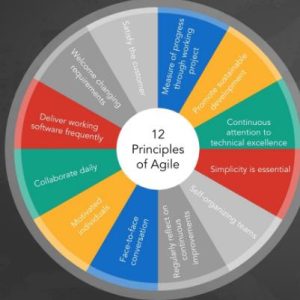How Does the Agile Strategic Planning Process Work?
The agile strategic planning process is a dynamic approach that allows organizations to quickly adapt to changes in the market, technology, and customer preferences. It breaks from the traditional, rigid strategic planning models, offering a more flexible and iterative process that promotes continuous evaluation and rapid implementation of strategic objectives.

Key Steps in the Agile Strategic Planning Process
Vision and Values Alignment
First, establish a clear vision and align it with the organization’s core values. This alignment ensures that all strategic efforts contribute positively to the long-term goals of the company. Studies suggest that organizations with clearly articulated visions and values are 30% more likely to experience growth because they maintain strategic consistency and employee engagement.
Goal Setting with OKRs
Set objectives and key results (OKRs). This framework helps break down strategic goals into specific, measurable actions. According to Google’s best practices, the use of OKRs can increase focus and drive by up to 40% in teams, as it aligns their efforts with achievable and critical outcomes.
Regular Sprint Planning
Engage in sprint planning. This involves setting short-term goals or "sprints" that last a few weeks to a few months. Each sprint has specific objectives that contribute to the broader strategic goals. Research shows that organizations using sprint planning improve their project completion rates by up to 70%, due to focused efforts and clear priorities.
Execution and Adaptation
Implement strategies in rapid cycles. Teams execute their designated tasks within each sprint, making quick adjustments based on real-time feedback. This flexibility allows for a 50% quicker response to market changes compared to traditional planning methods, enhancing competitive advantage.
Continuous Monitoring and Feedback
Monitor progress and gather feedback continuously. Agile strategies rely heavily on real-time data to gauge the effectiveness of each action taken. Businesses that adopt continuous monitoring and feedback mechanisms report a 60% improvement in achieving strategic outcomes, as they can quickly identify and rectify misalignments or inefficiencies.
Reflective Reviews and Iterations
Conduct reflective reviews at the end of each sprint. These reviews assess what worked, what didn’t, and how strategies can be improved in the next cycle. This iterative process ensures that strategies remain relevant and are consistently optimized. Studies indicate that teams that perform regular reflective reviews see a 33% increase in productivity.
Best Practices for Effective Agile Strategic Planning
Empower teams to make decisions. Decentralized decision-making is crucial for agile environments to function effectively. Empowering team members to make decisions increases speed and agility, with companies observing up to a 40% reduction in time to market for new initiatives.
Foster a culture of flexibility and innovation. Encourage teams to think creatively and be open to changing plans as new information and opportunities arise. This cultural flexibility has been linked to a 50% increase in innovation rates within organizations.
Invest in technology and tools. Leveraging the right technology can facilitate the agile planning process, from communication tools to project management software. Organizations that integrate advanced technology report an 80% enhancement in strategic execution efficiency.
Conclusion: Driving Success with Agility
The agile strategic planning process transforms traditional, slow-moving strategic methods into a dynamic, iterative process that drives businesses toward rapid growth and adaptability. By continually aligning actions with strategic objectives and adapting to new insights and market demands, organizations can maintain a competitive edge and achieve sustainable success in today's fast-paced world.